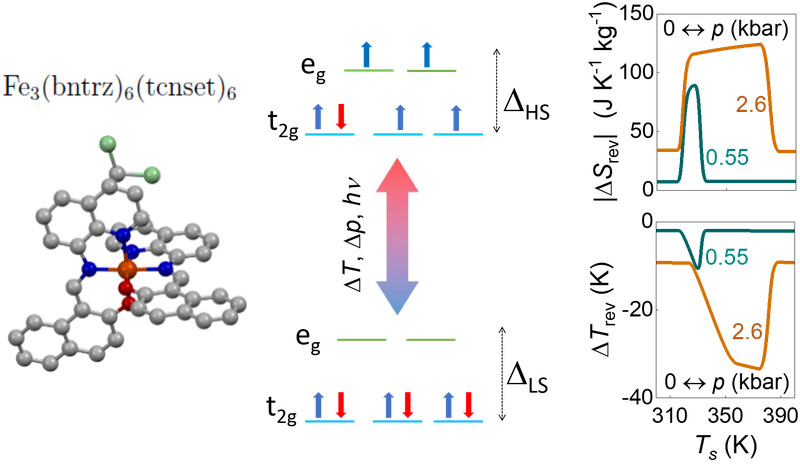Discovered a spin-crossover compound for solid-state cooling
Jul 20, 2021
Researchers from the Group of Characterization of Materials at the Department of Physics of the UPC along with international collaborators have discovered a spin-crossover compound that undergoes a giant thermal response driven by pressure. This work, published in Advanced Materials, open routes to exploit this type of compounds in future solid-state refrigeration technologies as alternative to current methods that use harmful fluids
The exchange of the latent heat in liquid-vapor transitions driven by pressure is the basis for current cooling methods, but the fluids used therein pose a serious environmental problem due to their huge greenhouse potential. Solid-state first-order phase transitions have been proposed as environmentally friendly alternatives but the lack of proper materials limit their implementation. One of the main problems is the transition hysteresis, that may hinder the cyclability of the thermal response and increase the necessary input work. Recently, a work contributed by researchers from the UPC, the University of Barcelona, the Anakara University (Turkey), the University of Science and Technology Beijing (China), the Florida State University (USA), the National High Magnetic Field Laboratory (USA) and the Synchrotron ALBA-Cells (Spain) has revealed a giant thermal change associated with a spin transition that can be driven reversibly under moderate pressure changes thanks to a very small transition hysteresis.
In particular, this compound is a molecular material containing a trinuclear transition metal complex that undergoes an abrupt spin crossover from a state in which all threee FeII centers are in the high-spin (S = 2) electronic configuration and a state in which they are in the low-spin (S = 0) electronic configuration. The large volume and entropy changes occurring at the transition yield a sensitivity of the transition temperature to pressure of K kbar-1 near room temperature. In turn, these transition features along with a narrow hysteresis of ~2 K allows that pressure changes of 0.55 and 2.6 kbar yield, respectively, isothermal entropy changes of 80 J K-1 kg-1 and 120 J K-1 kg-1 and adiabatic temperature changes of 10 K and 35 K. These joint values are among the highest reversible values reported for any material so far. Our study should inspire the development of future environmentally-friendly solid-state barocaloric cooling devices.
This work was published in Advanced Materials with the reference:
M. Romanini, Y. Wang, K. Gurpinar, G. Ornelas, P. Lloveras, Y. Zhang, W. Zheng, M. Barrio, A. Aznar, A. Gràcia-Condal, B. Emre, O. Atakol, C. Popescu, H. Zhang, Y. Long, L. Balicas, J. Ll. Tamarit, A. Planes, M. Shatruk, L. Manosa, Giant and Reversible Barocaloric Effect in Trinuclear Spin-Crossover Complex Fe3(bntrz)6(tcnset)6, Advanced Materials, 33, 2008076 (2021)

Share: